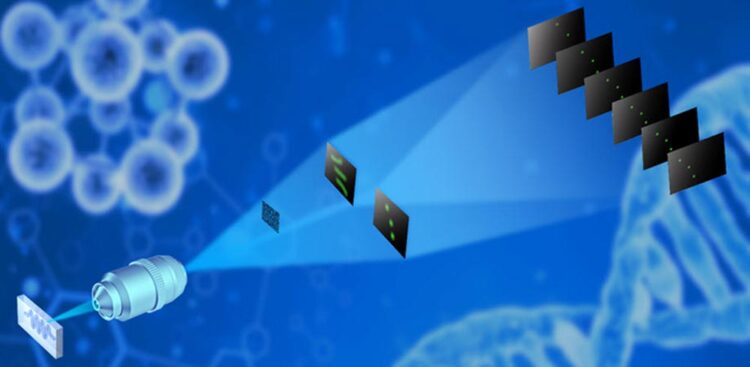High-speed super-resolution microscopy via temporal compression

Temporal compressive super-resolution microscopy (TCSRM) acquires a super-resolution image sequence from temporally compressed and transiently sampled measurements.
Credit: Shian Zhang (East China Normal University)
New high-speed super-resolution imaging technique resolves a longstanding contradiction between spatial resolution and imaging speed.
As an indispensable tool for observing the microcosmos, optical microscopy has boosted the development of various fields, including biology, medicine, physics, and materials. However, optical diffraction imposes a spatial resolution restriction on optical microscopy, which hampers exploration of finer structures.
To overcome the resolution limitation, various super-resolution microscopy techniques based on diverse principles have been proposed. Yet these techniques commonly acquire super-resolution at the expense of reduced imaging speed, so achieving high-speed super-resolution imaging that can detect fast dynamics with fine structures has remained a great challenge.
Recently, a research team from East China Normal University, Shenzhen University, and Peking University resolved the contradiction between the spatial resolution and imaging speed. As reported in Advanced Photonics, they achieved high-speed super-resolution by developing an effective technique termed temporal compressive super-resolution microscopy (TCSRM). TCSRM merges enhanced temporal compressive microscopy with deep-learning-based super-resolution image reconstruction. Enhanced temporal compressive microscopy improves the imaging speed by reconstructing multiple images from one compressed image, and the deep-learning-based image reconstruction achieves the super-resolution effect without reduction in imaging speed. Their iterative image reconstruction algorithm contains motion estimation, merging estimation, scene correction, and super-resolution processing to extract the super-resolution image sequence from compressed and reference measurements.
Their studies verified the high-speed super-resolution imaging ability of TCSRM in theory and experiment. To demonstrate the imaging capability of TCSRM, they imaged flowing fluorescent beads in a microchannel, achieving a remarkable frame rate of 1200 frames per second and spatial resolution of 100 nm.
According to corresponding author Shian Zhang, Professor and Deputy Director of the State Key Laboratory of Precision Spectroscopy at East China Normal University, “This work provides a powerful tool for the observation of high-speed dynamics of fine structures, especially in hydromechanics and biomedical fields, such as microflow velocity measurement, organelle interactions, intracellular transports and neural dynamics.” Zhang adds, “The framework of TCSRM can also offer guidance for achieving higher imaging speed and spatial resolution in holography, coherent diffraction imaging, and fringe projection profilometry.”
Read the Gold Open Access article by Y. He, Y. Yao, et al., “Temporal compressive super-resolution microscopy at frame rate of 1200 frames per second and spatial resolution of 100 nm,” Adv. Photon. 5(2), 026003 (2023), doi 10.1117/1.AP.5.2.026003.
Journal: Advanced Photonics
DOI: 10.1117/1.AP.5.2.026003
Article Title: Temporal compressive super-resolution microscopy at frame rate of 1200 frames per second and spatial resolution of 100 nm
Article Publication Date: 9-Mar-2023
Media Contact
Daneet Steffens
SPIE–International Society for Optics and Photonics
daneets@spie.org
Office: 360-685-5478
All latest news from the category: Physics and Astronomy
This area deals with the fundamental laws and building blocks of nature and how they interact, the properties and the behavior of matter, and research into space and time and their structures.
innovations-report provides in-depth reports and articles on subjects such as astrophysics, laser technologies, nuclear, quantum, particle and solid-state physics, nanotechnologies, planetary research and findings (Mars, Venus) and developments related to the Hubble Telescope.
Newest articles

Properties of new materials for microchips
… can now be measured well. Reseachers of Delft University of Technology demonstrated measuring performance properties of ultrathin silicon membranes. Making ever smaller and more powerful chips requires new ultrathin…

Floating solar’s potential
… to support sustainable development by addressing climate, water, and energy goals holistically. A new study published this week in Nature Energy raises the potential for floating solar photovoltaics (FPV)…

Skyrmions move at record speeds
… a step towards the computing of the future. An international research team led by scientists from the CNRS1 has discovered that the magnetic nanobubbles2 known as skyrmions can be…





















